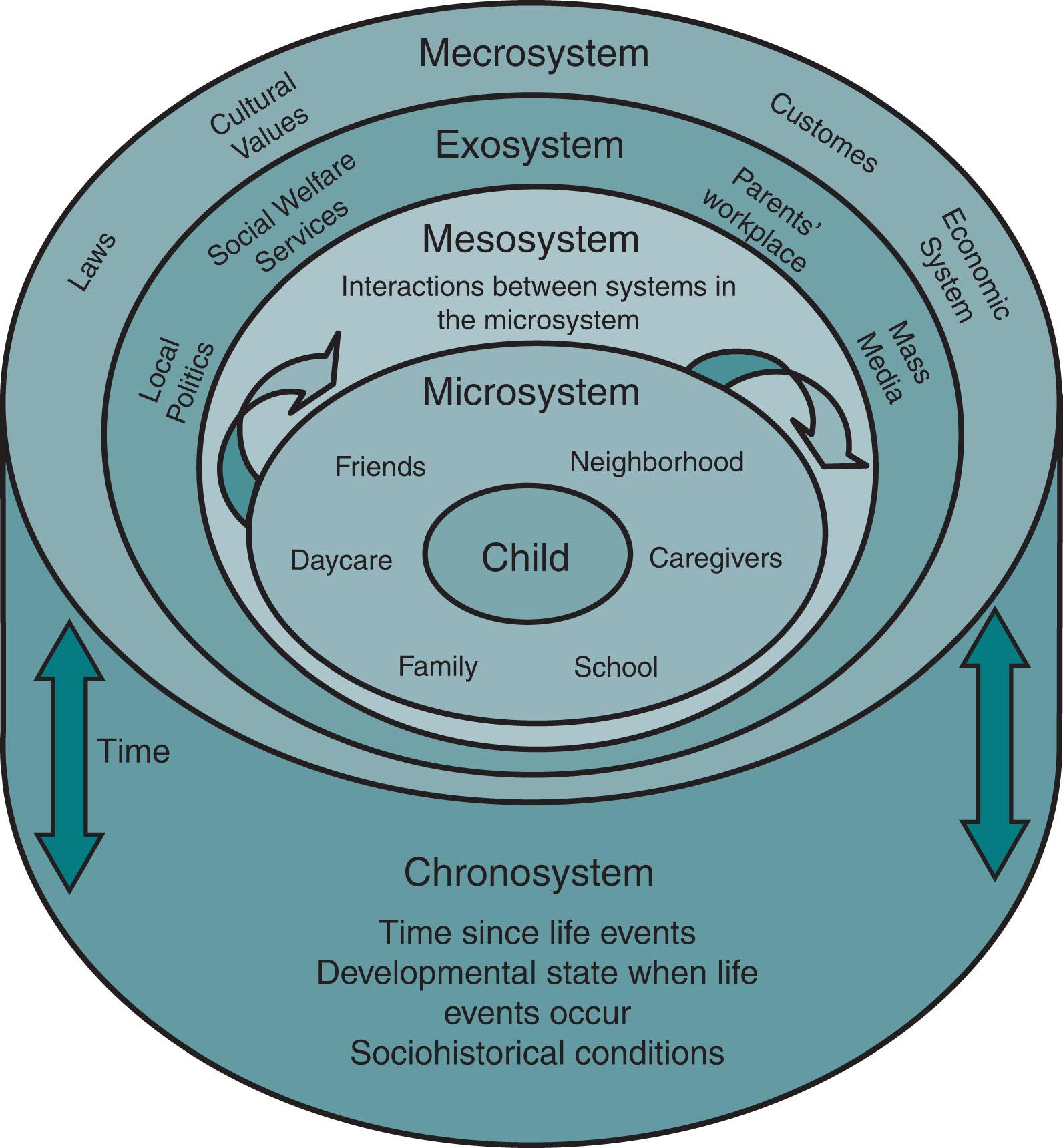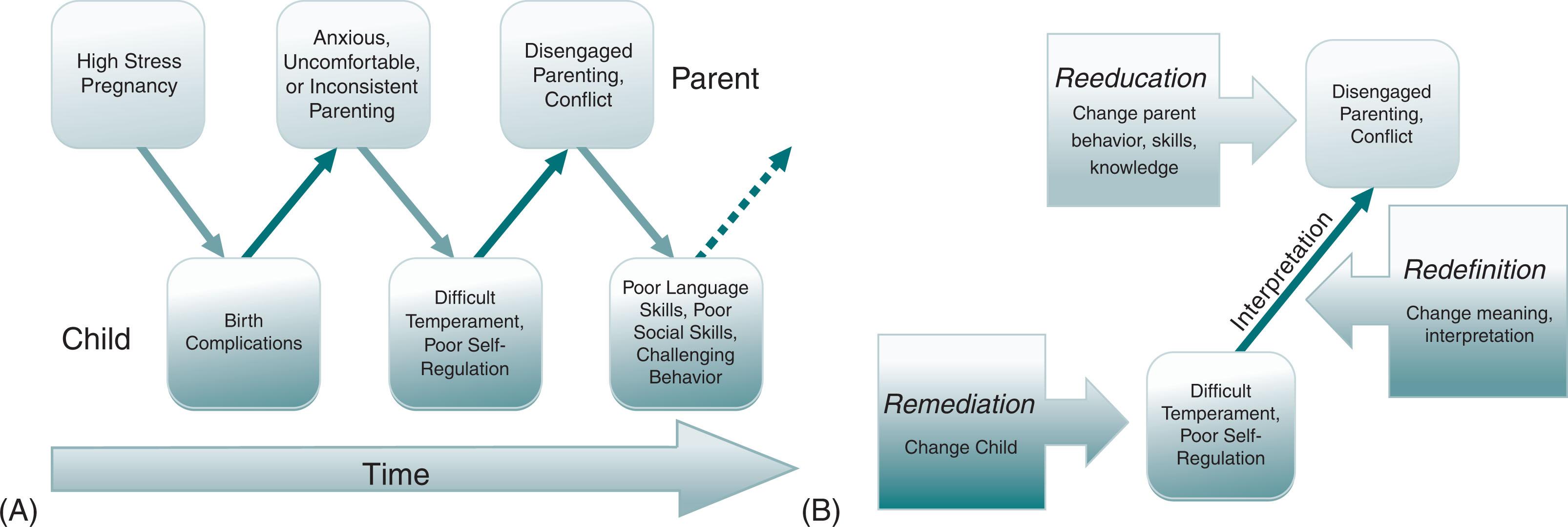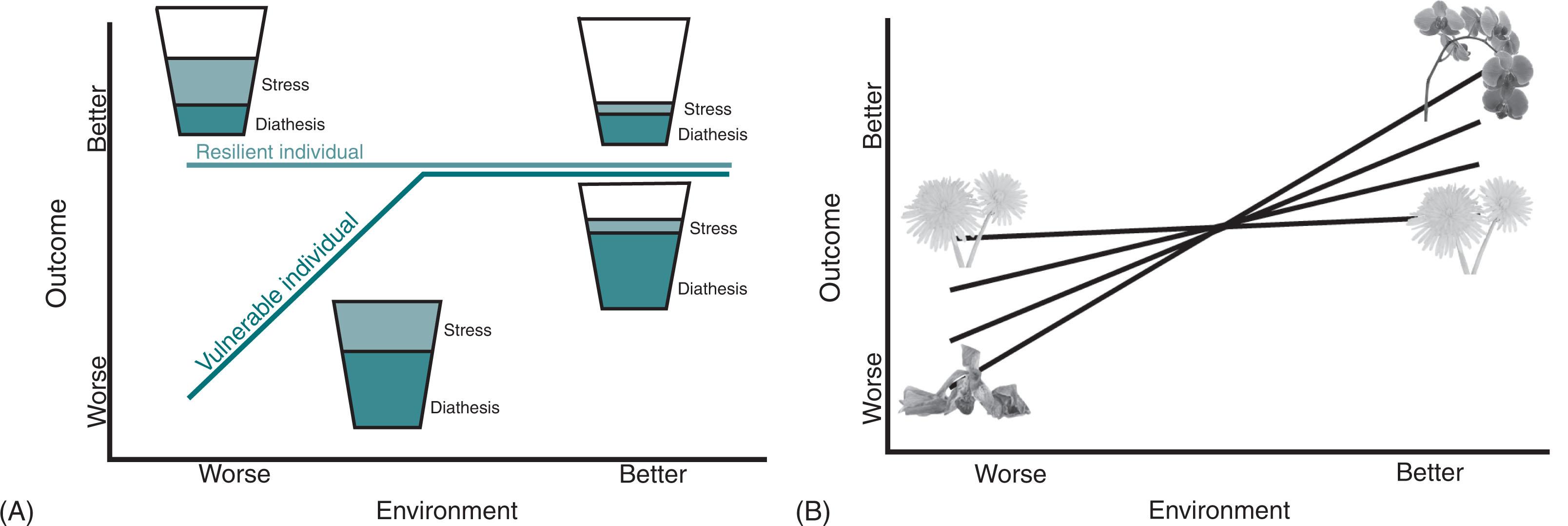Physical Address
304 North Cardinal St.
Dorchester Center, MA 02124
For additional material related to the content of this chapter, please see Chapters 3 , 5 , 15 , and 24 .
Justin, a 6-year-old boy, and his mother, Cynthia, come into the office for a new-patient appointment. Upon reviewing his chart, you see that Justin was born at 34 weeks of gestation and had exposure to nicotine in utero. As soon as you enter the room, tension is clear; Justin appears withdrawn and ashamed, and Cynthia appears overwhelmed and frustrated. You ask, “What brings you to the clinic today?” Cynthia says harshly, “Justin is out of control. If he doesn’t get his way, he hits and yells. I don’t know what to do with him. His school calls me a few times a week to pick him up because of his behavior. I can’t keep doing this—I’m going to lose my job if I keep having to call off because of him.” Justin sits quietly, looking down to the floor as you talk. You learn that Justin has been struggling for about 3 years. Cynthia’s social support is limited—she is a single mother, following a contentious separation from Justin’s father 2 years ago. Justin’s father has not been in regular contact. Cynthia becomes more emotional as you ask about the circumstances of their separation. She shares that her relationship with Justin’s father became abusive. Justin had witnessed many physical and verbal altercations between them .
Children’s behavior and development is impacted by a plethora of biologic, psychological, and social factors. As our understanding of the brain and the biology of behavior advances, so too does the window through which we understand clinical scenarios such as that of Cynthia and Justin in the opening vignette. The early years—from pregnancy through early childhood—are characterized by rapid development, with many neural structures being built and organized during this time. In these years, experience is most able to “get under the skin” to shape a child’s later development. Processes such as neural pruning and DNA methylation (see Chapter 24 ) allow experience to alter a child’s developing brain, such that brain architecture itself is built through the dynamic interaction of biology and environment. In this chapter we review how nature and nurture interact in meaningful ways for a range of important outcomes and the implications for clinical care.
Biology influences behavior and environment, and behavior and environment influence biology throughout development. Children are directly and indirectly influenced by both their proximal context (e.g., relationships with their caregivers) and broader societal factors (e.g., neighborhood violence, community-wide belief systems). Children’s development is the product of the accumulation of everyday interactions and experiences as well as the broader community and cultural context in which they are raised. While major events (e.g., changes in family structure) and circumstances (e.g., family resources) are important to children’s development, so too are the minute interactions that make up day-to-day life. The multilevel and transactional influences on children’s development have been described in two key theoretical models.
Urie Bronfenbrenner’s ecological systems theory ( ) proposes there are multiple levels of influence on a child’s development, spanning from relationships with caregivers to systems such as schools and workplaces, to events in the broader society ( Fig. 2.1 ). The microsystem describes the direct relationships and interactions children have, such as with caregivers, siblings, and peers. These individuals directly influence the child by scaffolding development, providing opportunities to play and learn, and providing emotional support to children. The microsystem also contains structures with which the child interacts, such as school, neighborhood, childcare settings, and family. Children both influence and are influenced by these relationships and structures (e.g., a child’s temperament may contribute to setting the tone of a classroom). The mesosystem describes interaction among the structures that are in the microsystem (e.g., bidirectional influences between neighborhoods and schools). The exosystem consists of larger social systems that impact structures in the microsystem (e.g., community-based family resources or parental work schedules). Children do not directly interact with the exosystem, but they experience the impact of changes in these social systems. The macrosystem is the outermost layer of a child’s environment and is defined by cultural values, customs, and laws that influence the ways that the inner layers function. The chronosystem captures the influence of time on children’s development, reflecting both developmental processes that take place over time and the changing influence of events (e.g., a traumatic event) based on their duration and the developmental stage in which they occur.

Arnold Sameroff’s transactional model builds on Bronfenbrenner’s ideas about the bidirectionality of effects on children’s development. It discusses the processes that take place between parents and children in everyday interactions and over time ( ). This model grew out of observations that many risks, such as premature birth or birth complications, were associated with observable developmental problems only for some children—most often those children with additional social risks (e.g., low socioeconomic status). In other words, children’s environments moderate the effect of early biologic risks on children’s development. Nature and nurture are viewed as inherently inextricable; genes are expressed dependent on one’s environment, and parents respond differently to children based on the child’s inherent biologic characteristics.
An illustration of this cascading effect in a mother-child dyad is shown in Fig. 2.2A . A child’s characteristics impact parenting, and parenting impacts children’s development; these bidirectional cascades of influences continue over time across development. Critically, parents’ behaviors in response to children are driven by their interpretations and the meaning they make from the behavior. For instance, a parent’s anxious handling may arise because of her perception about the child’s birth complications (e.g., “He’s fragile and I might hurt him by accident”); a parent may disengage from a child with a difficult temperament because of the meaning she attaches to the child’s fussy behavior (e.g., “Nothing I do settles him, he must not want me”).

Understanding these processes provides several potential ports of entry for intervention in the parent-child relationship (i.e., the three R s: remediation, redefinition, reeducation); changing any of these ports of entry has the potential to change the sequelae that follow (see Fig. 2.2B ). Remediation refers to directly changing the child. If a child has gastroesophageal reflux that contributes to a difficult temperament, treating the reflux might reduce the child’s fussiness, and in turn, the parent may show more warmth and sensitivity with the child. Such treatment would be indicated when the child’s condition can be effectively treated. However, it is not always feasible to offer treatment, such as when the child’s condition is nonmodifiable or when there are no target symptoms that can be identified in the child that could be changed (e.g., with medical treatment or developmental therapies). Redefinition is changing a parent’s interpretations of, attitudes toward, or beliefs about the child. A clinician may help parents to think about what their child is thinking and feeling during a challenging moment, help parents to reinterpret their child’s behavior (e.g., aggressive behavior might reflect a child’s inability to put words to strong feelings), or reinterpret their role in an interaction with their child (e.g., being a supportive and warm presence can be helpful to your child, even if he doesn’t stop crying right away). This work often happens through parent-child psychotherapy, but modest redefinition can also occur through brief clinician visits. Reeducation refers to directly changing the parents’ skills or knowledge and is most effective when parents’ attitudes and beliefs about the child are healthy, but their parenting approach could be improved (e.g., by providing information about how to position a baby with a physical disability). Remediation, redefinition, and reeducation are inherently intertwined due to the dynamic nature of bidirectional influences in children’s development; a change in one domain will likely have cascading effects in other domains.
A combination of biologic and environmental factors contributes to the development of behavioral problems and psychopathology. For conditions such as attention-deficit/hyperactivity disorder (ADHD; see Chapter 48 ), heritability estimates are 50% or higher, though genetic influences typically interact with environmental influences in predicting outcomes. Early in infancy, children show differences in temperament, which are based on biology and can be considered the early roots of eventual psychiatric diagnoses. The dopamine D4 receptor (DRD4) and the serotonin transporter receptor (5-HTTLPR) are linked to aspects of temperament, including attention, novelty seeking, approach, and inhibition; but the effects of genes are dependent on environmental factors such as social-emotional experience (e.g., less sensitive parenting, child maltreatment). Thus even when the underlying risk is predominantly biologic, parenting and other environmental influences can either mitigate or amplify that risk. Children who are more vulnerable—whether from their genetic risk or temperament—are likely to be influenced more than the less vulnerable by both positive and negative experiences ( ). Abusive or neglectful parenting, poverty, premature birth, and parental psychopathology all place children at a higher risk for behavioral problems and psychiatric diagnoses, with higher risk for those children who experience multiple risk factors ( ). Neural plasticity, neural pruning, and epigenetic processes drive these environmental effects on children’s later outcomes. Two prominent theories have been developed to account for the ways that genetic and environmental factors interact.
This model suggests that some individuals are more vulnerable to the impacts of stress than others ( ) ( Fig. 2.3A ). Diatheses—hereditary or constitutional predispositions—might include biologic, genetic, temperament-related, or cognitive factors that predispose a child to being vulnerable to the influences of stress. Stresses might include discrete life events (e.g., divorce), chronic stresses (e.g., financial strain), or an accumulation of more minor daily stresses (e.g., school assignments). In a developmentally supportive environment, this model suggests that both resilient and vulnerable individuals are likely to do well. In a challenging environment, resilient individuals would do well, whereas vulnerable individuals would not. Those who have greater predispositions to psychopathology may be overwhelmed by a small to moderate environmental stress, whereas individuals with lower predispositions may withstand higher levels of environmental stress without apparent effects on their functioning.

This theory posits that individuals vary in their plasticity, or their level of susceptibility to environmental influences ( ) (see Fig. 2.3B ). Differential susceptibility can contribute to positive and negative outcomes. Some children, sometimes referred to as “orchids,” are very sensitive to their environment. When they are in an environment that is highly supportive of their development and well-being, they thrive; however, when they are in an environment that is unsupportive of their development, they struggle. Other children, sometimes referred to as “dandelions,” are less susceptible to environmental influences and will do roughly the same regardless of how supportive their environment and relationships are. Children can fall anywhere on the spectrum between these two extremes. This degree of plasticity has been linked to differences in genetic markers, including 5-HTTLPR , DRD4 , and BDNF ( , in press). A child’s susceptibility may differ depending on specific environmental influences and the specific outcome being considered.
Become a Clinical Tree membership for Full access and enjoy Unlimited articles
If you are a member. Log in here